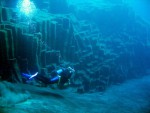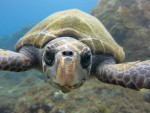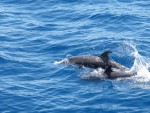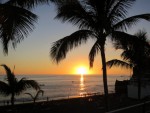Due to their volcanic origin, diving on the coasts off La Palma in the clean waters of the East Atlantic offers an impressive, fascinating backdrop. One of the peculiarities of La Palma is its rapidly descending steep cliffs. Already 3 km off the coast of Puerto Naos the 1000m depth line is reached. In some 200m off the coast, you can dive in the open Atlantic and meet big fish.
Here you can see our trailer about diving with us:
The underwater world of La Palma is characterized by unique volcanic underwater landscapes. The lava flows, the basaltic formations and numerous archways, grottoes and some caves are building a bizarre underwater lava world. Everywhere you can find intact subtropical habitats with numerous marine species. Turtles are sighted more frequently. In the columns there are often carp shrimp and other species of prawns, as well as ghost crab and others. Sting-, Butterfly- and Eagle Stingrays are often to meet in sandy areas and also Mobulas with a little luck.
Sharks, Tuna and Mackerels/ Jacks can also be sighted. In boat dives, you can also observe sea mammals like dolphins, Grind whales and Bryde-, Pilot- or Sperm whales with a little bit of luck.
The unique underwater landscape around La Palma can be experienced through the outstanding visibility. The view is often up to 50m and allows a fantastic hovering in bizarre landscapes. The waters of the East Atlantic in the area of the island are characterized by temperatures from a minimum of 19° -20°C in March / April to 26°C in September. Even at Christmas, the water temperature is often 23°C.There are no layers of Thermoclines.The air temperatures are always in a pleasant range between 18°C at night and 24° – 30°C during the day.
All year diving on La Palma
The small size of the island makes it possible to dive all year round. In the summer, June to October, the North-East Passat influences the weather with a steady, often strong wind. The west coast is at this time in the wind shade and offers best diving conditions.In addition, the west coast is the sunniest region on the island.Rough waves on the west side are rare, but could be strongly in autum like November and Dezember. In case of bad conditions wencan reach in about 40 minutes the south-east side, which can then offer during this time by the wave shadow good diving conditions.
On the Internet you can sometimes read that the weather on the east side of La Palma would be better. This is not quite true. Through the north-east Passat there is the fog forest on the north-east side and in Cancajos large wave breakers. Bathing would otherwise often be impossible or troublesome by the rising waves produced by the Passat.
Another great advantage at the Westseite as a holiday destination – what is more beautiful than a successful diving or holiday day with a sunrise!




